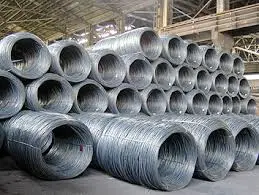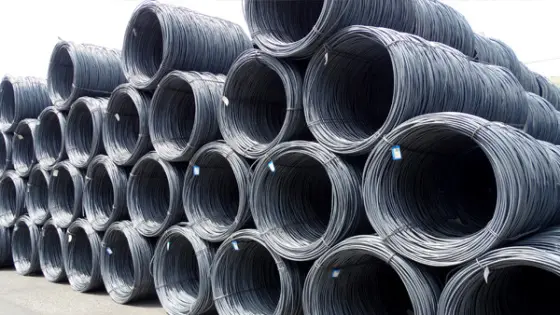Wire rod: the "metal blood" of modern industry
Wire rod is also called Wire Rod, usually refers to small diameter round steel in coils. The diameter of the wire rod is in the range of 5-19 mm (usually 6-9 mm), and its lower limit is the minimum size of the hot-Rolled Steel section.


Wire rod is a relatively small diameter round steel, which is supplied in coils. The common ones on construction sites are 6, 8, 10, and 12 mm in diameter, mostly low-carbon steel. It is generally not used for the main reinforcement of reinforced concrete structures, but is mostly used to make steel sleeves. There are also small diameter ones used for "transfer reinforcement" in transition-mixed structures.
Wire rod, also known as wire rod, usually refers to a small diameter round steel in a coil. The diameter of the wire rod is in the range of 5-19 mm (usually 6-9 mm), and its lower limit is the minimum size of the hot-rolled steel section.
The specifications of the wire rod mainly include the following:
1. Diameter specifications
Coils are usually distinguished by their diameter, with common diameters including 5mm, 6mm, 8mm, etc. Different diameters of wire rods are suitable for different purposes, such as construction, manufacturing, textiles, etc.
2. Material specifications
Wire rods can be divided into ordinary carbon steel wire rods, high-quality carbon structural steel wire rods, alloy steel wire rods, etc. according to their materials. Coils made of different materials have varying mechanical and chemical properties, making them suitable for different working environments and applications.
3. Intensity level
The strength level of the wire rod is also an important parameter of its specifications. Common strength levels include low strength, medium strength, and high strength. Wire rods of different strength levels have differences in load-bearing capacity, fatigue resistance, and are suitable for manufacturing different structural components and parts.
4. Surface treatment
The surface treatment method of the wire rod can also affect its specifications. Common surface treatment methods include smoothing, galvanizing, and oiling. Different surface treatment methods can affect the corrosion resistance, appearance quality, and service life of the wire rod.
Wire rod is an important metal material widely used in various fields such as construction, manufacturing, and textiles. Its specifications are diverse, and suitable wire rods can be selected according to different needs and uses. When selecting wire rods, it is necessary to consider specifications such as diameter, material, strength level, and surface treatment to ensure that they meet usage and performance requirements. In addition, factors such as production process and quality of the wire rod need to be considered to ensure the selection of high-quality wire rod.Wire rod is a relatively small diameter of round steel, the commodity form is rolled into a disc supply, common on the construction site with a diameter of 6, 8, 10, 12 mm, mostly low carbon steel, generally not used for the main reinforcement of reinforced concrete structures, mostly used for making steel sleeves, and small diameter for brick-concrete structures in the "brick reinforcement".
There are many varieties of wire rods, and the low-carbon steel wire rod in the carbon steel wire rod is commonly known as the soft wire, and the medium and high carbon steel wire rod is commonly known as the hard wire. Wire rods are mainly used as blanks for wire drawing, but can also be used directly as building materials and processed into mechanical parts. Stainless steel wire rod is used in the manufacture of stainless steel wire, stainless steel spring steel wire, stainless steel top forged steel wire and steel wire for stainless steel wire rope.
There are many varieties of wire rods. Low carbon steel wire rods in carbon steel wire rods are commonly known as soft wires, and medium and high carbon steel wire rods are commonly known as hard wires. Wire rods are mainly used as blanks for wire drawing, and can also be directly used as building materials and processed into mechanical parts. Stainless steel wire rods are used to make stainless steel wire, stainless steel spring wire, stainless forging wire and stainless steel wire rope wire. With the advancement of production technology, wire rods with square, hexagonal, fan-shaped and other special-shaped sections have appeared; the upper limit of the diameter has been expanded to 38 mm; the weight of the coil has increased from the original 40-60 kg to 3000 kg.
Wire rod is the smallest cross-sectional size among hot-rolled steel sections. It generally refers to hot-rolled round steel with a diameter of 5-60mm or special-shaped steel with equivalent cross-section. Because it is delivered in coiled state, it is collectively called wire rod or wire rod.
Wire is a long strip of steel with a small diameter. It is widely used in many fields such as construction, manufacturing, automobiles and agriculture. It is usually supplied in coils or straight bars. The size ranges from a few millimeters to tens of millimeters. The length can be customized to meet the requirements of specific projects. In terms of material, steel wire is mainly made of carbon steel, but also includes special steels such as stainless steel and alloy steel to provide different strength, toughness and corrosion resistance. According to different uses and characteristics, wire is classified into low-carbon wire, high-carbon wire, stainless steel wire and alloy steel wire, etc. In accordance with international and regional standards, steel wire has strict regulations on size, chemical composition and mechanical properties to ensure its reliability and safety in various industrial applications.















